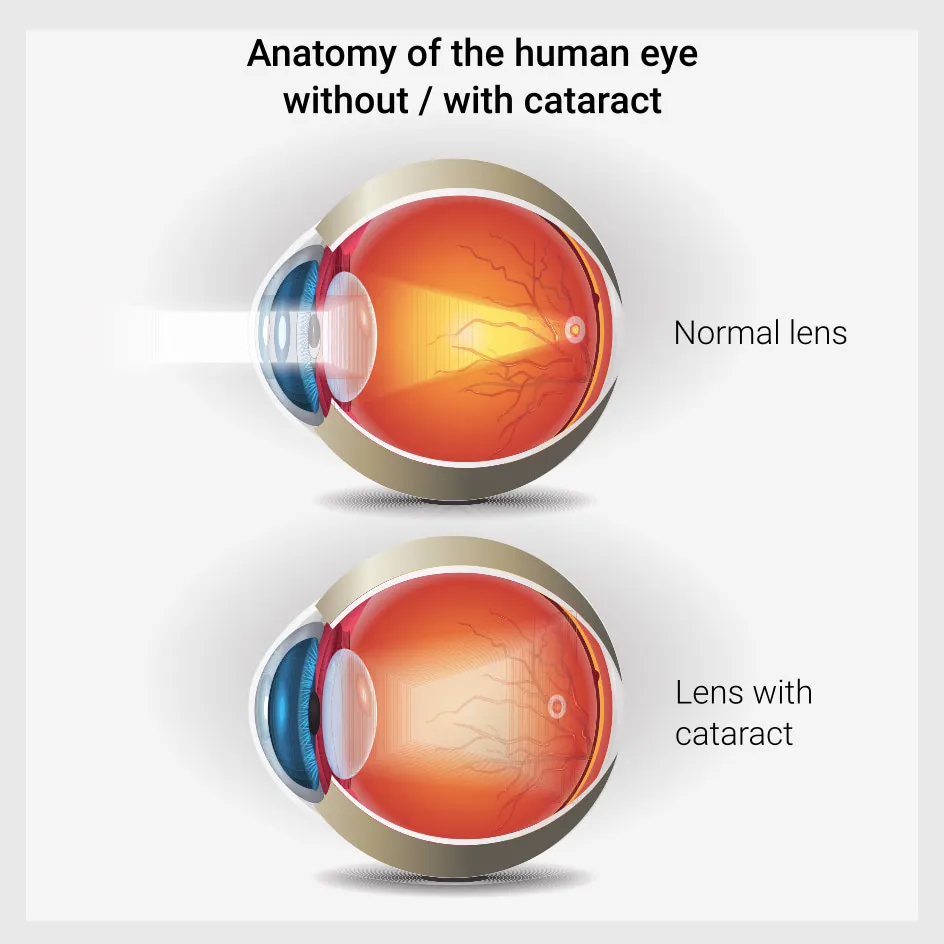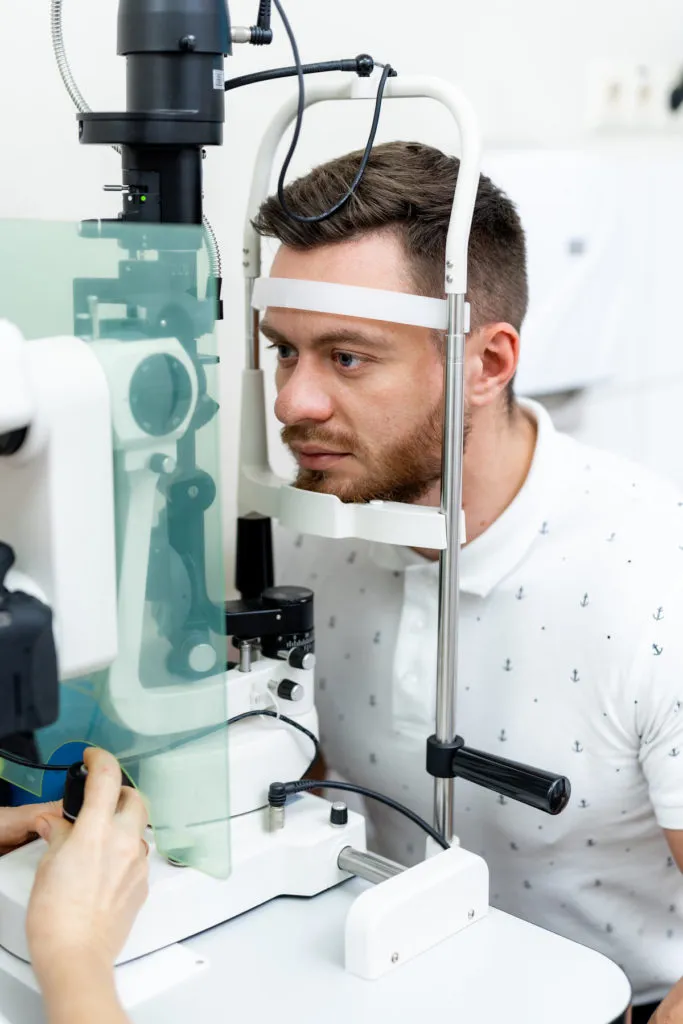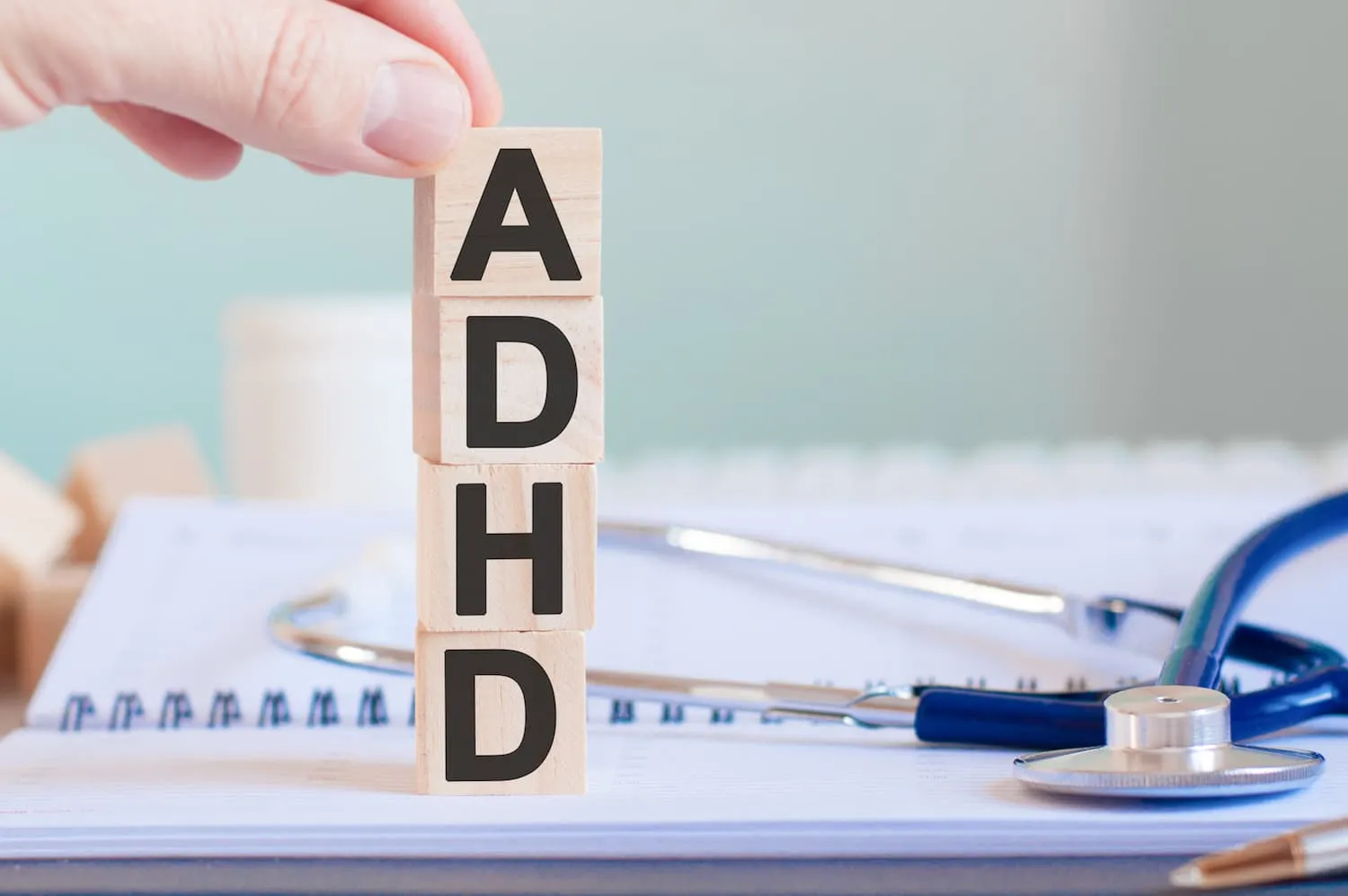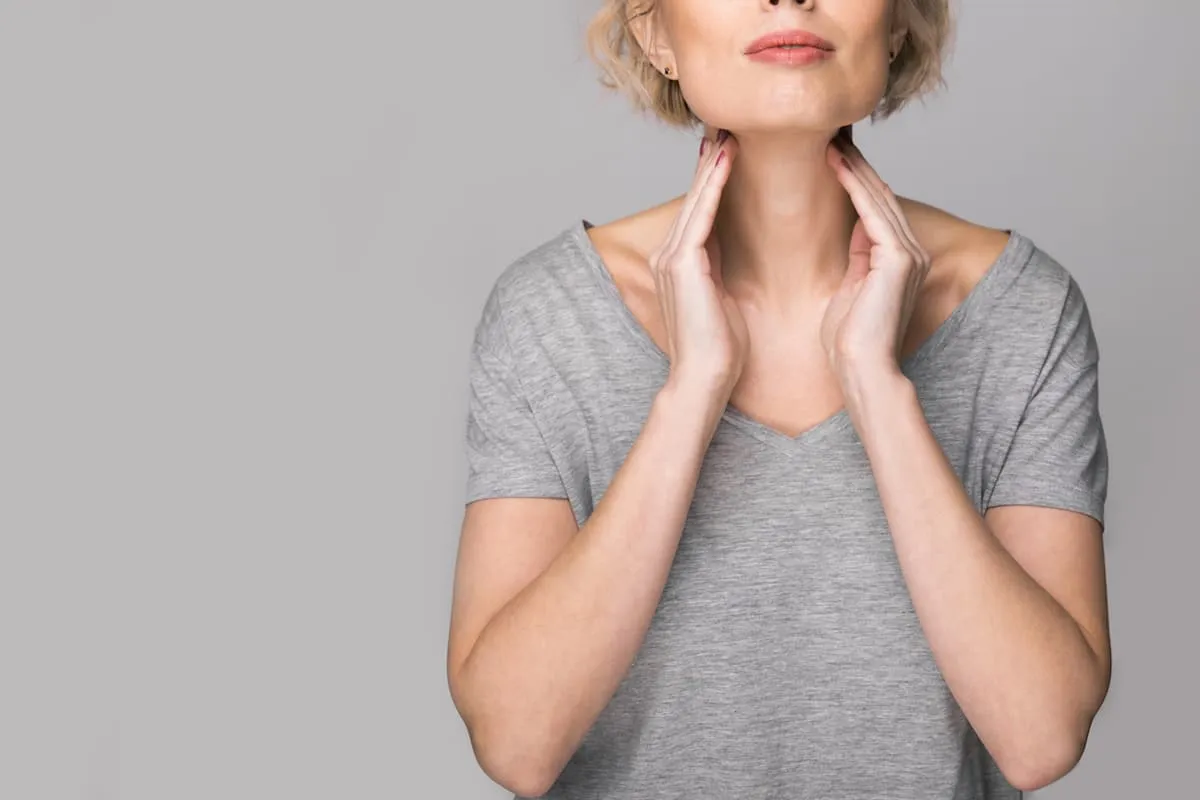Updated on 17. February 2022 from ÁYIO-Q Redaktion
Reading time: approx. 15 minutes
What to do when the view becomes cloudy?
Cataract is an eye disease in which the otherwise clear lens becomes increasingly cloudy. As a result, vision steadily decreases. Cataracts are usually caused by age, but they can also be the result of metabolic diseases or eye deformities and injuries. If it is left untreated, it leads to visual impairment. Learn more about the symptoms, triggers and medical help for cataracts below!
- Description
- species
- Signs & Symptoms.
- Causes
- Diagnosis
- Conventional treatment
- risk factors
- Natural & alternative therapy options
What is a cataract?

A cataract is a dense, cloudy spot that develops in the lens of the eye. A cataract develops when healthy proteins in the eye clump together, preventing the lens from sending clear images to the retina. The retina converts the light that passes through the lens into signals. It sends the signals to the optic nerve, which transmits them to the brain.
Die Entwicklung ist langsam und beeinträchtigt schließlich Ihre Sehkraft. Der Graue Star kann in beiden Augen auftreten, entsteht aber normalerweise nicht gleichzeitig. Er sind vorwiegend ältere Menschen davon betroffen. Mehr als fünfzig Prozent der Menschen in den Vereinigten Staaten haben Katarakte oder haben sich einer Kataraktoperation unterzogen, wenn sie 80 Jahre alt sind, so das National Eye Institute.
What are the different types of cataract?
There are 5 main types of cataracts:
1. Age-related cataract
With age, a cataract can form due to natural changes in the lens of the eye. This is called an age-related cataract and is one of the most common types of cataracts. Age-related cataracts may be more likely to develop if you:
- consume too much alcohol
- smoking
- Cataract runs in the family
- have diabetes mellitus
- Have had certain eye surgery treatments, such as glaucoma surgery.
- Taking steroids (medicines to treat various health problems, such as arthritis or allergic reactions) over a long period of time.
2. Traumatic Cataract
Severe eye injuries can damage the lens and cause a cataract. The cataract can form quickly after the injury – or it can develop many years later.
3. Cataract due to radiation.
Certain types of radiation can trigger cataracts. These are ultraviolet (UV) rays from sunlight and radiation treatments of cancer cells.
4. Paediatric Cataract
Children can also get a cataract. They can be born with cataracts (congenital cataract) or develop them later.
Cataracts in children are rare and usually inherited – they run in families. However, it can also be caused by significant problems during pregnancy or diseases in youth, such as uveitis or lumps in the eye. Children can also get cataracts for the same reasons as adults: Eye injuries, radiation or steroid medication.
If a child’s cataract is large enough to cause vision problems, it must be treated immediately. It is important to treat these cataracts early so that your child does not develop various other vision problems such as amblyopia (low vision).
Several other paediatric cataracts are so small that they do not affect your child’s vision. Your child’s doctor can keep an eye on these smaller cataracts to make sure they do not cause any visual problems.
5. Secondary Cataract (posterior capsular opacity)
After cataract surgery, some people may experience a problem called a second cataract, which clouds vision again. This condition is also called a post-cataract or posterior capsule opacification. Second cataract is common, but can be very easily corrected with laser therapy at your ophthalmologist.
During cataract surgery, your doctor removes the lens from your eye and replaces it with a clear artificial lens. But gradually, the thin membrane layer that holds the new lens in place can expand and cloud your vision again.
Signs and symptoms of a cataract
Signs of a cataract
If your vision becomes cloudy and the world seems to disappear behind a veil, this could be a sign of the eye disease cataract. Because the lens becomes greyish and also cloudy as the disease progresses, the term “grey” is used. The name “cataract” comes from the fixed gaze that sufferers have when they are (virtually) blinded by the eye disease.
The clinical term for cataract comes from the Greek and means “waterfall”. In the past, it was assumed that clotted fluid in the eye triggered the clouding of the lens.
The most common symptoms of cataract are:
- Blurred/obscured vision
- Difficulty seeing in the evening
- Discolouration of the shadows
- Increased sensitivity to light
- Atriums around lights
- Double vision in the affected eye
- Need for frequent changes in spectacle prescription
Symptoms during the course of cataract disease.
Depending on the stage, cataracts cause different symptoms. At the beginning of the disease, vision decreases and those affected are very sensitive to glare. A kind of haze forms in the centre of the field of vision, obscuring objects or making them appear as if behind a veil.
The veil becomes denser over time and spreads to the entire field of vision as the disease progresses. Shades, contrasts and contours gradually fade and seem to merge. Spatial perception and thus the ability to form relationships diminish.
As the disease progresses, cataracts cause signs and symptoms that can severely affect those affected in their daily lives. These consist of:
- Glare sensitivity (e.g. sunshine or flash)
- Impaired visual understanding
- Worse light-dark adaptation
- Severe eye fatigue when reading or watching television
- Limited spatial vision
- Insecurity in road traffic
These symptoms can vary in severity from person to person. They do not necessarily (all) occur
Finally, cataracts in the late stages make normal everyday life almost impossible: the eye’s performance can deteriorate so much within a short time that it amounts to blindness.
How does a cataract develop?
Most cataracts are caused by the typical changes in the eyes with age.
When you are young, the lens in your eye is clear. Around the age of 40, the proteins in the lens of your eye start to break down and clump together. This clumping forms a cloudy spot on the lens – a cataract. Over time, the cataract becomes more extreme and clouds the lens more and more.
There are a number of other causes of cataracts. These include:
- An overproduction of oxidants, which are oxygen molecules that have been chemically altered by normal daily life
- Cigarette smoking
- Ultraviolet radiation
- Long-term use of steroids and various other medications
- certain diseases, such as diabetes
- Trauma
- Radiotherapy
- Various other metabolic diseases, such as:
- Calcium deficiency (hypocalcaemia)
- Hyperparathyroidism (overactive parathyroid gland)
- Excess ferritin in the blood (ferritin is an iron storage protein)
- Galactosemia (a congenital disorder in the utilisation of galactose, a sugar found in breast milk).
How does your doctor diagnose a cataract ?
Your doctor will certainly do a thorough eye test to check for cataracts and to analyze your vision. This includes extensive eye tests to check your vision in different areas and a Tonometry to determine your eye pressure.

The usual tonometry examination uses a painless blast of air to flatten the cornea and determine eye pressure. Your doctor will certainly also put drops in your eyes to dilate your pupils. This makes it easier to examine the optic nerve and retina in the back of the eye for damage.
Other tests your doctor may perform include checking your sensitivity to glare and your colour perception.
If there is another underlying disease, the cataract is often the first indication of this. Especially in young people, additional examinations are necessary, e.g. skin and muscle examinations as well as blood tests. This can detect tetany (abnormal muscle pain), myotonia (muscle tissue disease), skin diseases, Wilson’s disease (congenital disorder of copper metabolism) or diabetes mellitus.
Conventional treatment of cataracts (cataract)
If you are unable or not interested in surgery, your doctor can help you manage your symptoms. He might recommend stronger contact lenses, stronger glasses, or sunglasses with sufficient glare protection.
Surgical Intervention
Surgery is suggested if the cataract prevents you from performing your daily tasks, such as reading or driving. It is also performed if the cataract interferes with the treatment of various other eye problems.

In a surgical technique called Phacoemulsification, the lens is shattered with the help of ultrasonic waves and the pieces removed.
Extracapsular surgery involves removing the cloudy part of the lens through a long incision in the cornea. After the operation, a synthetic intraocular lens is inserted in the place of the natural lens.
Cataract removal surgery is generally very safe and has a high success rate. Risks of cataract surgery include infection, bleeding and retinal detachment, although the incidence of all these problems is less than 1%. Many people can go home the same day after the operation.
Risk factors for a cataract (cataract)
The dangers associated with cataracts include:
- old age
- excessive drinking
- smoking
- obesity
- hypertension
- previous eye injuries
- family history of cataracts
- excessive sun exposure
- diabetes mellitus
- direct radiation exposure from X-rays and also cancer cell treatments
4 Holistic & Natural Therapies to Treat Cataracts.
There is still no drug treatment for cataracts. However, in the case of senile cataract, oxidative damage to the lens during a long life plays a crucial role. Theoretically, antioxidants in the form of vitamins, fruits and vegetables should stop this damage. Thus, the following applies to the prevention of age-related cataracts: eat a healthy diet and protect your eyes from UV radiation.
1. Medicinal plants
Eine generelle Wirkung von antioxidativ wirkenden Pflanzenstoffen gegen den Grauen Star ist plausibel, allerdings gibt es noch keine schlüssigen Studien, die eine Wirkung belegen. Aus einem wissenschaftlichen Artikel, an dem insgesamt 10 Wissenschaftler aus verschiedenen Ländern mitgewirkt haben, geht jedoch hervor, das Heilpflanzen und Naturprodukte sehr wohl hilfreich sein könnten und daher dringend weitere Studien erfolgen sollten.
Antioxidant plant substances are found in high amounts in the following plants:
- Turmeric
- Ginkgo
- Green tea
- Garlic
- Grape seed extract
There is clinical evidence of cataract safety. This would certainly be conceivable with various other plants such as acerola cherry, broccoli, cranberry, galangal, pomegranate, chocolate and sea buckthorn berry, to name but a few.
2. Homeopathy
A holistic approach to cataracts should be embedded in an alternative concept at the same time. An already existing lens opacity cannot be reversed by a homeopathic treatment!
The following are just examples, a homeopath must choose the solution that is right for him:
- Potassium dihydrogen phosphate (Kalium phosphoricum): Cataract in combination with exhaustion, dizziness as well as ringing in the ears
- Naphthalene (naphthalinum): in patients with bronchial asthma, cataracts or emphysema
- Causticum (Causticum): Cataract – acute with flickering, sparking and opacity
- Hemlock (Conium): severe cataract with photophobia as well as injuries
- Fly agaric (Agaricus muscarius):Cataract chronic, after exertion, eye muscle twitching.
- Autumn crocus (Colchicum): Cataract with rheumatic constitution
Tissue salts for cataracts:
- No. 1. calcium fluoratum: to strengthen the tissue and the stability of the lens.
- No. 11. Silicea: for the preservation of the vitreous body.
- No. 5. potassium phosphoricum: for cloudiness of the lens
3. vitamins & minerals
Vitamin A deficiency also leads to cataracts in children. In our latitudes, however, this deficiency disease practically does not occur.
Cataracts are significantly influenced by oxidative processes. Consequently, the eye is the body organ with the highest antioxidant protective powers in the body. From this it was concluded that antioxidants should have a protective effect.
In this context, vitamins C, E and carotenoids are particularly important. However, vitamins from the B group such as vitamin B3 (niacin), vitamin B1 (thiamine) and also vitamin B2 (riboflavin) can also make a contribution. Furthermore, the enzymes need the aspects zinc, molybdenum as well as selenium to fight oxidative stress.
The eye normally contains a lot of vitamin C
The liquid eye juice that surrounds the lens consists of a lot of Vitamin C. As a result, the vitamin can protect the lens from oxidation processes and prevent the cloudiness typical of cataracts. Therefore, it makes sense to take even more vitamin C to protect the eye from cataracts or to stop their progression.
The more vitamin C, the rarer the cataract.
In a recent London study published in the journal Ophthalmology, cataracts were observed in 324 pairs of female twins aged 60 to 70 over a 10-year period. In addition, the diet and vitamin C intake of the subjects were assessed.
It showed that cataracts progressed much more slowly (33 per cent slower) in the people who ate the most vitamin C-rich foods, and the lens was still much clearer and brighter after ten years than in the people on a low vitamin C diet plan.
In addition, it was found that cataracts are much more influenced by environmental factors and dietary habits than by hereditary factors.
The human microorganism cannot produce vitamin C itself and is therefore dependent on an external supply.
Manganese
Besides vitamin C, the trace element manganese also helps to protect the eye from cataracts, according to the result of the study. It is mainly found in black tea as well as in cereal products, for example bran.
4. Eye exercise for cataract
With the “Yoga exercises for the eyes” you can achieve an improvement in vision and relax equally exhausted eyes.
See for yourself and try the following eye exercises. Please keep them for 5 minutes daily and practice them for at least 6 weeks:
Part 1 – Preparation:
- Stand upright, e.g. on a chair, stool, seat cushion
- Make sure you sit upright yet relaxed
- Please do not lean, but sit freely
- In this position, pull both shoulders up strongly towards your ears and inhale deeply and consciously
- Now let the shoulders sink down and breathe out very slowly
- Repeat this 3 – 5 times and also come increasingly more to rest
Part 2 – Now the eye exercises await you:
- Keep your head straight with your chin pulled slightly towards your sternum and also the crown of your head facing directly into the space above you
- Mentally imagine a watch with your clock face
- First move your eyes up to 12 o’clock, then down to 6 o’clock. Repeat this very slowly, 6 times in total. Perform the entire series of movements while keeping your head really still
- Now move your eyes from 3 o’clock to 9 o’clock and back. Repeat this 6 times
- Move your eyes diagonally from 11 o’clock to 5 o’clock and back again
- Then from 1 am to 7 am and back. Additionally 6 times each
- Hold a thumb outstretched at the level of the nose at a distance of about 20 centimetres
- Make sure your shoulders stay loose
- Now direct your attention to a point in front of you in the room that is also at the same height as your nose and more than 2 m away from you.
- Now look alternately at the point in space in front of you, then at your thumb, then at the tip of your nose, then again at the point in space in front of you, then at your thumb, the tip of your nose, and so on. Repeat this 3-4 times. Now look back and forth between your thumb and the point in space 3-4 times alternately, then between your thumb and the tip of your nose 3-4 times, and finally from the tip of your nose to the point in space 3-4 times alternately.
- Now lower your arm. Breathe in and out gently and relax.
- Close your eyes and rub the palms of your hands together vigorously until they become warm.
- Once the palms are almost hot, close your eyes and place your warm palms on your eyes. You can keep your eyes closed or open your eyes and explore the “black” of your hands. Let the warmth flow into your eyes
- Feel your eyes relax. Repeat the relaxation exercise again if you feel like it and if time allows.
You can also do the relaxation exercise during the day at work, it relaxes strained “screen eyes”.
FAQ
How can I prevent cataracts?
You can take measures to protect your eyes:
- Wear sunglasses and a brimmed hat to protect yourself from the sun.
- Give up smoking cigarettes.
- Keep a healthy eating plan. Eat lots of vegetables and fruit – especially dark leafy vegetables like spinach, kale and kohlrabi.
- Have an eye examination with pupil dilation. If you are 60 years or older, you should have an eye examination with pupil dilation at least every 2 years.
What are the consequences of a cataract?
When cataract has already manifested itself in an advanced stage, even the right measures cannot reverse the clouding of the lens. It can both hinder daily activities and lead to loss of vision if not counteracted in time. Some cataracts stop growing but do not reduce in size by themselves. If the impairment becomes too great, the only remedy is surgery by inserting an artificial lens.
ICD-Codes für diese Krankheit: H25 | H26 | H28 | Q12
ICD codes are internationally valid codes for medical diagnoses. They can be found, for example, in doctors’ letters or on certificates of incapacity for work.
The web content of ÁYIO-Q.com is for your information and in no case replaces a personal consultation or treatment by a qualified physician. The contents of ÁYIO-Q.com cannot and must not be used to make independent diagnoses or for self-medication.
Sources:
- Tewari D, Samoilă O, Gocan D, et al. Medicinal Plants and Natural Products Used in Cataract Management. Front Pharmacol. 2019;10:466. Published 2019 Jun 13. doi:10.3389/fphar.2019.00466
- Lim V, Schneider E, Wu H, Pang IH. Cataract Preventive Role of Isolated Phytoconstituents: Findings from a Decade of Research. Nutrients. 2018;10(11):1580. Published 2018 Oct 26. doi:10.3390/nu10111580
- Yonova-Doing E, Forkin ZA, Hysi PG, et al. Genetic and Dietary Factors Influencing the Progression of Nuclear Cataract. Ophthalmology. 2016;123(6):1237-1244. doi:10.1016/j.ophtha.2016.01.036
- King`s College London. “Increased vitamin C in the diet could help protect against cataracts” ScienceDaily. ScienceDaily, 23. März 2016, Zugriff 20.12.2021















